A Bus Interchange or Bus Terminal is a public transport facility that functions as the start and end point of bus routes. These centralized facilities allow for seamless transfer between bus services. There are currently 26 bus interchanges and 19 bus terminals in operation.
Locality Map
Bus Interchanges
A Bus Interchange (referred to as a Bus station outside of Singapore) is a large facility handling many bus routes, usually offering connections to the Mass Rapid Transit (MRT) network. They are an integral part of Singapore’s hub-and-spoke public transportation system, where commuters frequently rely on buses for last-mile connections.
| Bus Interchange | Bus services |
| Ang Mo Kio | 22, 24, 25, 73, 86, 130, 133, 135, 136, 138, 166, 169, 261, 262, 265, 269 |
| Bedok | 7, 9, 14, 16/16M, 17, 26, 30, 30e, 32, 33, 35/35M, 38, 40, 60, 69, 87, 155, 168, 196, 197, 222, 225G/225W, 228, 229, 401, 854, 854e |
| Bishan | 50, 52, 53, 54, 55, 56, 57, 58, 59, 410G/410W |
| Boon Lay | 30, 79, 154, 157, 172, 174, 174e, 178, 179, 180, 181/181M, 187, 192, 193, 194, 198, 199, 240, 241, 242, 243G/243W, 246, 249, 251, 252, 405 |
| Bukit Batok | 61, 77, 106, 173, 177, 189, 852, 941, 945, 947, 990, 991, 992 |
| Bukit Merah | 5, 16/16M, 57, 75, 123, 131, 132, 139, 153, 167, 176, 198, 272, 273, 851 |
| Bukit Panjang | 176, 180, 920, 922, 970, 972/972M, 973, 975, 976, 979 |
| Choa Chu Kang | 67, 172, 188, 188e, 190, 300, 301, 302, 307, 925, 927, 976, 983, 985, 991 |
| Clementi | 7, 14, 96, 99, 147, 156, 165, 166, 173, 175, 196, 282, 284, 285 |
| Compassvale | 110, 374 |
| Eunos | 22, 60, 61, 63/63M, 76, 93, 94, 150, 154 |
| HarbourFront | 65, 80, 93, 123M, 124, 188, 188e, 855, 963, 963e |
| Hougang Central | 27, 51, 74, 89, 89e, 102, 107/107M, 112, 113, 116, 132, 147, 151, 153, 161, 165, 324, 325, 329 |
| Joo Koon | 99, 182/182M, 253, 254, 255, 257, 258, 974 |
| Jurong East | 41, 49, 51, 52, 66, 97, 97e, 98/98M, 105, 143/143M, 183, 197, 333, 334, 335, 506, 993 |
| Jurong Town Hall | 78, 160, 870, CW3, CW4, CW4S |
| Pasir Ris | 3, 5, 6, 12, 12e, 15, 17, 21, 46, 58, 68, 88, 354, 358, 359, 403, 518, 518A |
| Punggol | 3, 34, 43/43M, 43e, 50, 62, 82, 83, 84, 85, 117/117M, 118, 119, 136, 381, 382G/382W, 384, 386 |
| Sembawang | 117/117M, |
| Sengkang | 80, 83, 86, 87, 156, 159, 163, 371, 372, 965 |
| Serangoon | 100, 101, 103, 105, 109, 158, 315, 317, 506 |
| Tampines | 3, 4, 8, 10, 19, 20, 23, 28, 29, 31, 37, 38, 65, 67, 68, 69, 72, 81, 127, 291, 292, 293, 296, 969 |
| Tampines Concourse | 39 |
| Tampines North |
18, 129, 298 |
| Toa Payoh | 8, 26, 28, 31, 73, 88, 90, 139, 141, 142, 143, 145, 155, 157, 159, 163, 230, 231, 232, 235, 238 |
| Woodlands (Temporary Bus Interchange) |
925/925M, 950, 961/961M, 965 |
| Woodlands (Integrated Transport Hub) |
161, 168, 169, 178, 187, 856, 858, 900, 901/901M, 902, 903/903M, 904, 911, 912/912M, 913/913M, 960, 960e, 962, 963, 963e, 964, 966, 969 |
| Yio Chu Kang | 13, 70/70M, 71, 72, 76, 162, 825, 860 |
| Yishun | 39, 85, 103, 171, 800, 801, 803, 804, 805, 806, 807, 811, 812, 851, 851e, 852, 853/853M, 854, 854e, 855, 856, 857, 859, 860, AC7 |
Integrated Transport Hub (ITH)
Several bus interchanges are designated as Integrated Transport Hubs, which have fully air-conditioned passenger concourses with links to rail stations. These are often built within commercial and residential buildings as part of an integrated development.
At present, the various ITHs in operation are:
- Toa Payoh (May 2002)
- Sengkang (Jan 2003)
- Ang Mo Kio (Apr 2007)
- Boon Lay (Dec 2009)
- Serangoon (Sep 2011)
- Clementi (Nov 2011)
- Bedok (Nov 2014)
- Joo Koon (Nov 2015)
- Bukit Panjang (Sep 2017)
- Yishun (Sep 2019)
- Woodlands (Jun 2021)
Bus Terminals
A Bus Terminal is a smaller facility used as a regional terminating point for bus services. While the majority are dedicated facilities, there are a handful of roadside bus terminals with minimal infrastructure. Some bus terminals do not allow for passenger boarding and alighting.
| Bus Terminal | Bus services |
| Beach Station | 123, Sentosa Bus A, Sentosa Bus B |
| Buona Vista | 32, 48, 74, 91, 145, 185, 191, 200 |
| Changi Airport Terminal 2 | 24, 27, 34, 36, 53, 110, 858 |
| Changi Business Park | 47, 118 |
| Changi Village | 2, 29, 59, 109 |
| Gali Batu | 75, 184 |
| Ghim Moh | 92/92M, 100, 111 |
| JB Sentral | 160, 170X, 950, other JB local bus routes |
| Kampong Bahru | 2, 12, 12e, 54, 120, 122, 174, 174e, 190 |
| Kent Ridge | 10, 33, 95, 151, 200, 201, NUS A1, NUS A2 |
| Larkin | 170, other JB local bus routes |
| Lorong 1 Geylang | 11, 140, 141, 175, 853, 961/961M, 980, 985 |
| Marina Centre | 56, 77, 97, 97e, 195, 960, 960e |
| Queen Street | 170, CW2, SJE |
| Resorts World Sentosa | 123, RWS8, Sentosa Bus A |
| Saint Michael’s | 21, 124, 125, 129, 131, 186 |
| Shenton Way | 70, 106, 107, 121, 130, 133, 186, 400, 970 |
| Sims Place | 64, 134, 137 |
| Tuas | 192, 193, 247, 248, 248M |
| Upper East Coast | 13, 25, 43, 45, 46, 55, 137, 853M |
In addition, some bus depots are used as route termini of bus services, as follows:
| Bus Depot | Bus services |
| Ang Mo Kio | 45, 265, 268 |
| Bedok North | 18, 48 |
| Soon Lee | 185, 502/502A |
Bus termini used only by private buses:
| Bus Terminal | Bus services |
| Little India | Little India Bus Services Private buses to/from workers’ dormitories |
| Prince George’s Park | NUS A1, NUS D2, NUS BTC, NUS K |
Bus Parks
Bus Park used to park buses only, with no boarding and alighting activities allowed:
| Bus Park | Remarks |
| Hougang Bus Park | Supports Hougang Central Int during construction of the Cross Island Line Hougang Station |
Upcoming Bus Interchanges & Terminals:
Works in Progress / Construction Tenders Issued
- Woodleigh Integrated Transport Hub
(Under Construction, projected opening in 2019 & delayed to end 2024) - Buangkok Integrated Transport Hub
(Under Construction; projected opening in Q3 2023 & delayed) - Punggol North Integrated Transport Hub
(Under Construction) - Tengah Bus Interchange
(Under Construction) - Pasir Ris Integrated Transport Hub
(Tender Phase, opening around 2028) - Jurong East Integrated Transport Hub
(Tender Phase) - Kallang Bus Interchange
(Integrated with Kallang Horizon BTO Project; Under Construction) - Beauty World Integrated Transport Hub
(Mixed-use Development at Bukit Timah; within Bukit V Mall) - Tuas Transport Hub
(Bus terminal at Tuas Port)
Under Planning
- Bedok South Integrated Transport Hub*
- Hougang Integrated Transport Hub*
- Tampines Integrated Transport Hub
- Tampines North Integrated Transport Hub*
- Tengah Integrated Transport Hub*
- Tiong Bahru Integrated Transport Hub*
- Marina South Integrated Transport Hub^
- Woodlands North Integrated Transport Hub (Shelved)
- Choa Chu Kang Integrated Transport Hub
* – As per URA Draft Master Plan 2019
^ – As per Land Transport Master Plan 2040
List of abolished Bus Interchanges and Terminals: In addition, several bus services terminate at bus stops which do not count as bus termini. These are: In the past, private bus companies built and operated their own bus termini. They were usually located along the roads and were plenty in number, adding to the difficulty of integrating various different bus routes. In the 1970s, smaller-scaled bus terminals were built, most of them by the Public Works Department (PWD) and the Housing and Development Board (HDB). The private bus companies would then rent these terminals for thousands of dollars per month. In the late seventies, the construction of new towns resulted in the idea of regional bus interchanges to take over the roles of the bus terminals. This would improve efficiency and reduce overlapping of bus routes. In 1978, the Jurong Bus Interchange became Singapore’s first bus interchange. The early bus interchanges were mainly shared by the SBS, TIBS, SSB and Scheme B bus operators. Until the completion of the Woodlands Bus Interchange in 1996 by the Mass Rapid Transit Corporation (MRTC), all the early bus interchanges were designed and built by the Housing and Development Board (HDB), which was also the main architect of bus stops and other facilities for the public transport. With the construction of the MRT in the 1980s, bus transport in Singapore slowly adapted in favour of centralised bus interchanges that provide connections to the MRT, and the use of multiple feeder bus services to link up different parts of new towns with MRT stations. Also in 1983, the Government and its statutory boards took over five bus interchanges and more than 50 roadside termini from SBS. In the modern era, bus interchanges were further redesigned to provide greater comfort and integration. Toa Payoh and Sengkang Bus Interchanges were among the first to be fully air-conditioned and fully integrated with their basement MRT stations. Sengkang Interchange was also the first to integrate residential development with bus interchanges by the use of fully enclosed bus interchanges, i.e. the entire interchange occupies the ground floors of the building, a concept previously used extensively in land-starved Hong Kong. Integrated Public Transport Hubs have been built at Ang Mo Kio, Bedok, Serangoon, Boon Lay, Clementi and Joo Koon, and more are expected to be completed in the next decade, such as Bukit Panjang, Hougang, Jurong East, Marina South and Yishun. Today, bus interchanges are designed and constructed by the Land Transport Authority (LTA), but are managed by the bus operator which operates the majority of bus services from the interchange (and with the rollout of the Bus Contracting Model, bus interchanges/terminals are allocated to bus operators). Some bus terminals do not allow for passenger boarding and alighting. In the early 2010s, bus interchanges have been used for overnight parking of buses due to lack of parking space within bus depots, but the practice has been curtailed with the construction of more bus parks. Facilities: Bus interchanges (and some terminals) have one or more of such facilities:
Bus Services: 7, 9, 14, 16, 17/17A, 18, 25, 26, 30, 30e, 32, 33, 35, 38, 40, 60, 66, 69, 87, 168, 196, 197, 222, 225G, 225W, 228, 229, 401, 854, 854E
Bus Services: 75, 184
Bus Services: 160, 170X, 950, AC7, TS1, TS8
Bus Service: 975
Bus Service: 402
Bus Services: 2, 12, 12e, 54, 120, 121, 122, 174, 174e, 190, CT8, CT18
Bus Service: 63
Bus Services: 70, 106, 107, 128, 130, 133, 162, 186, 400, 402, 700, 970
Bus Service: 49
Bus Services: 192, 193, 247, 248
Bus Services: 161, 168, 169, 178, 187, 856, 858, 900, 900A, 901, 902, 903, 903P, 904, 911, 912, 912P, 913, 925, 925#, 926, 950, 960, 961, 961#, 962, 963, 963E, 963R, 964, 965, 966, 969
Bus Services: 39, 85, 171, 800, 803, 804, 806, 811, 811P, 812, 812P, 851, 852, 853, 853#, 854, 854E, 855, 856, 857, 859, 860, AC7
Bus Services: 39, 85, 103, 171, 800, 803, 804, 805, 806, 807, 811, 812, 851, 851e, 852, 853, 853#, 854, 854e, 855, 856, 857, 859, 860, AC7
Service 146
Service 115
Service 53M
Services 42 & 135
Service 114
History:
Staffed by the bus operators, this office is the management center of any bus interchange. It handles passenger inquiries, timekeeping for bus services and various other interchange operations. They usually have a computer terminal for drivers to clock the start and end of their scheduled trips.
Staffed by TransitLink personnel, this office mainly handles contactless card transactions among other services.
Where bus drivers take a break before their next departure.
The National Transport Workers’ Union (NTWU) manages a group of canteens known as NTWU canteens which are commonly found at major bus interchanges. They provide healthy and low-cost meals for bus drivers, and are also open to members of the public.
Berths are pick-up areas for buses. Most major interchanges have three services assigned to a berth, with queuing areas for passengers.
Buses terminating at the interchange drop off passengers here before heading to park
Public transport operators design various information boards for their interchanges such as locality maps, bus service maps and bus information.
This electronic bus arrival board contains timings of the next scheduled bus departure.
The service guide rack is stocked with paper guides containing details of various bus services.
In recent years, bus operators have opened various stalls at their bus interchanges to increase profits by renting them out to vendors. Food stalls are among the most common.
Some bus interchanges charge a small fee for members of the public.
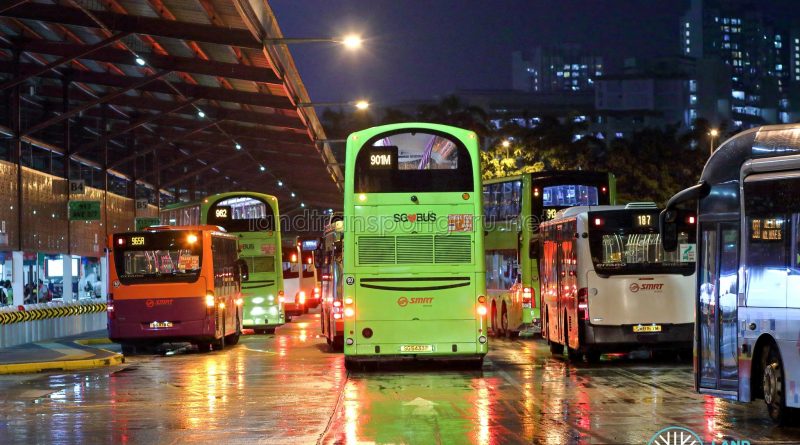
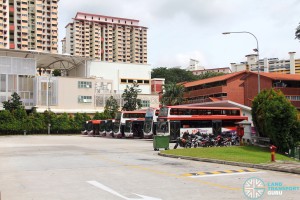
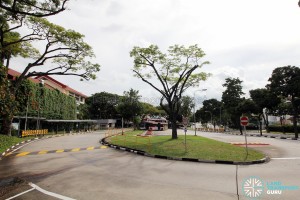
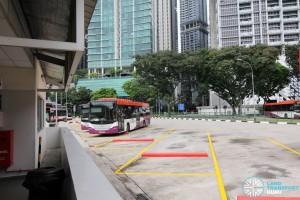
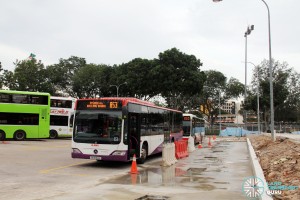
Marina Centre Bus Terminal should have been integrated within Marina Square or Suntec City Malls and allow public access. Easy and more convenient for people to take the bus.
Lor 1 Geylang Ter should be converted to a bus park when Kallang ITH opens.
Woodlands Temp Int rename to Woodlands Square Int since it definitely does not look like it is going away anytime soon, same as Punggol.
Compassvale Int close, 110 go to Buangkok ITH, 374 go back to Sengkang. 965 go to Buangkok, One of the other Sengkang services also amend.
LTA Should build Marina Bay Sands Integrated Transport Hub.
Extend all bus services from Marina Centre Terminal to start and terminate at Marina Bay Sands Integrated Transport Hub
LTA should build a new ITH called Khatib Integrated Transport Hub.
Should have a few more Interchanges in Singapore for more connectivity
1. Lim Chu Kang ITH (Located inside future LCK Mall)-Woodlands Bus Package
Services at LCKITH are 170x(extended), 432(New), 435(New), 438(New), 975
2. Lakeside ITH (Located next to Lakeside MRT and inside future Lakeside Square Mall)-Jurong West Package
Services at LSITH are 187(Amend), 192(Extend), 861(New),930(New), 931(New), 932(New), 936(New), 939(New)
3. Hillview Bus Interchange (Located next to Hillview MRT and Rail corridor)-CCK-Bukit Panjang Bus Package
services at Hillview INT are 61, 122, 653, 991(All amended)